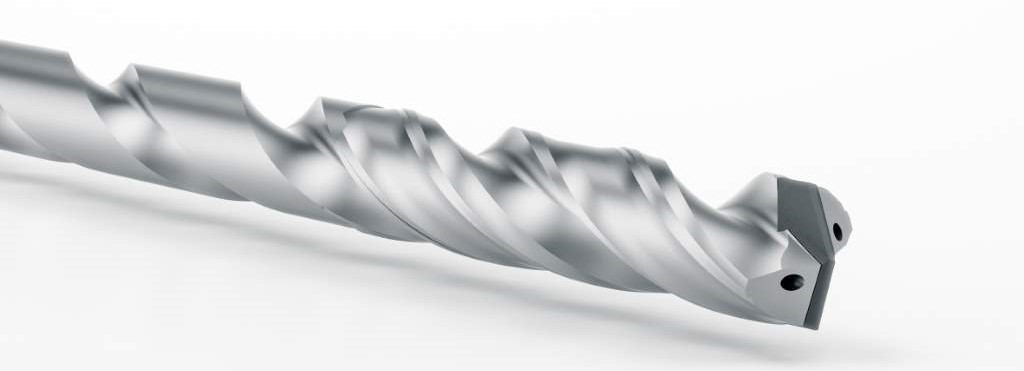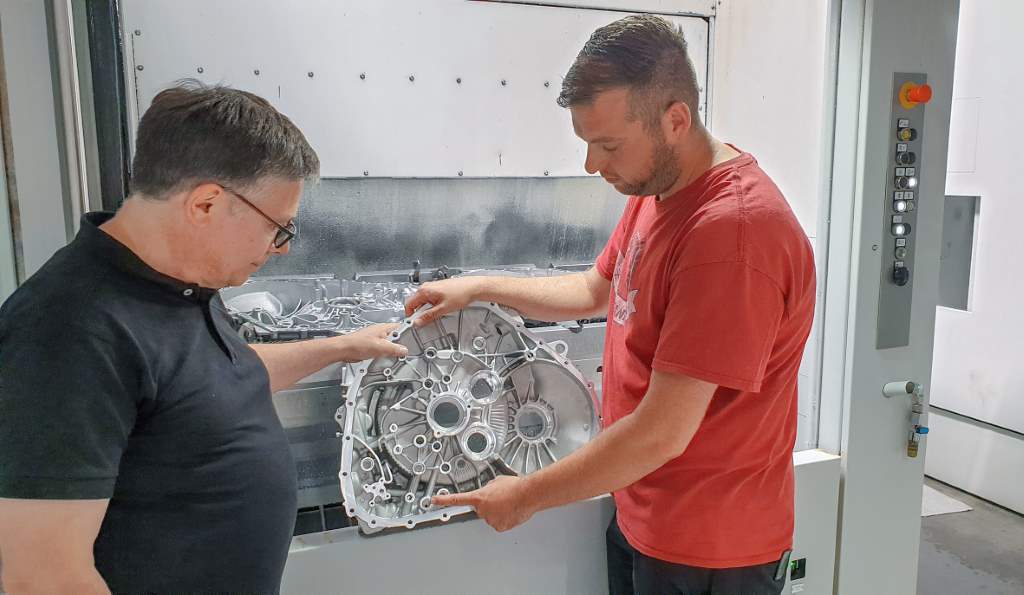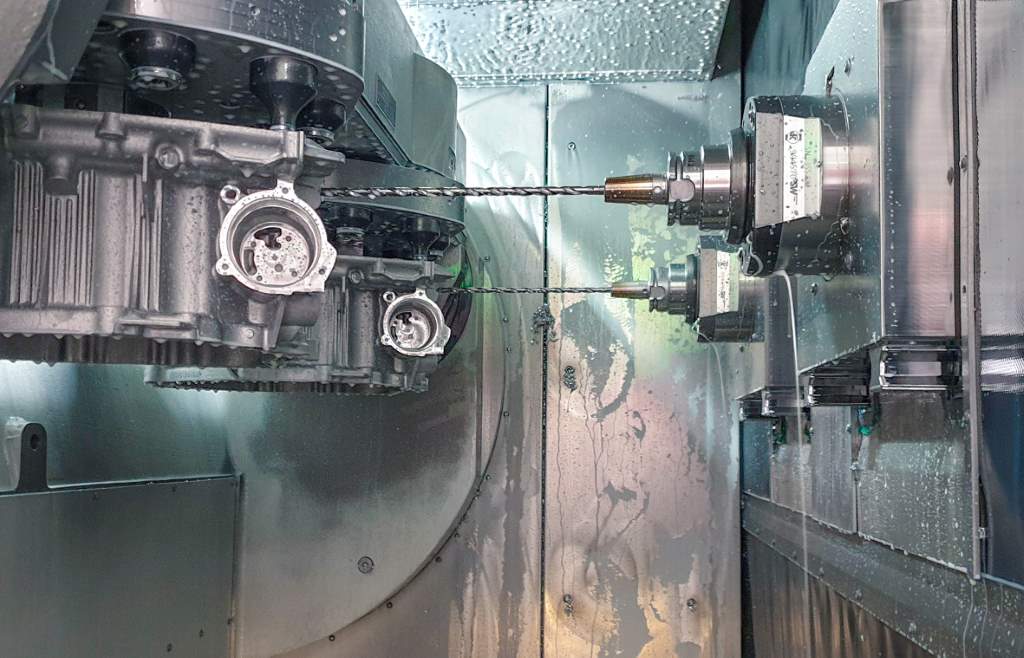When the Schlote Group built a new factory in Harzgerode, Germany in 2017, it was designed to mass produce only a single automotive transmission part. However, by optimising the cutting tools supplied by Mapal, the foundations have been laid so it can adapt to the trend for electric vehicles. PES reports.
Schlote’s story begins in 1969 as a small workshop in Harsum where the company is still headquartered. Today 11 companies with 1,800 employees belong to the Group.
The OEM has eight factories in Germany as well as further manufacturing facilities in the Czech Republic and China. Schlote Group customers include large car manufacturers, system integrators and foundries. Its turnover stems from engines (55%), transmissions (39%) and chassis (6%).
When the awarding of large contracts from major automotive OEMs transpired, Schlote entered into a joint venture with Bohai Trimet, an automotive aluminium die-cast specialist, to produce the parts in Harzgerode.
The transmission part manufactured at the Harzgerode factory is a die-cast aluminium clutch housing, delivered to various car manufacturers where they are predominantly installed in two-litre vehicle engines. While the transmission side is the same on all the clutch housings, the other side of the component – the bell housing that connects the transmission to the engine – has minor adaptations for respective car manufacturers’ engines.
The Schlote Harzgerode factory currently produces 4,000 parts per day and utilises a very high degree of automation. Around the clock, five days a week, 120 employees work at the facility and production can easily be expanded to six or seven days a week if required. As is the case generally in the automotive industry, the requirements placed on components are very high.

“The part we produce is not only an adapter flange, but also the rear of the transmission,” explains Sebastian Swiniarski, work preparation team leader at Schlote. “The bearing seats therefore require the highest degree of precision. There are many holes with different tolerances so accuracy is needed down to the thousandth of a millimetre.”
Successful improvement process
Mapal and the Schlote Group have enjoyed many years of effective cooperation. The tooling company was therefore entrusted with supplying PCD milling cutters (which create defined rough surfaces on which sealant is applied), tap drills, reamers and an array of diverse drilling tools.
“We offer our customers comprehensive solutions including the development of entire processes,” says Stefan Frick, Mapal’s technical advisor to Schlote.
A keen eye was kept on the performance of the Mapal tools from the very beginning. Since the Harzgerode site began operation, analysis has been performed continuously to find possible weak points and to optimise manufacturing.
Within the context of this continuous improvement process, Schlote and Mapal have managed to achieve longer tool life, lower tool expenditure and higher production quantities over the years. While 3,600 parts were produced at most per day in the beginning, the amount has now been raised to 4,500 parts – without the need for more CNC machines.

Drilling in depth
The newest optimisation of the production process involves deep drilling for oil channels used to change gears in the automatic transmission.
“We assess our tool management system each month to establish which tools have to be exchanged and how often,” Mr Swiniarski reports. “Time and again, the deep drills have proven to be the tools used the most. As these drills are relatively cost intensive, we have concentrated on improving their performance to further cut our tooling costs. Quality performance is also important as tool wear with a blunt drill produces burrs at the hole exit.”
In this example, two of the five deep holes being machined involve a diameter of 8mm and cutting depths of 180mm and 141mm. The holes run through the part from the side up to the bearing seat in the middle.
Solid carbide tools were originally used for this operation, and Schlote was able to achieve a tool life of 2,500 parts this way. However, the load monitoring system on the machine tool began to register tool wear at 2,000 parts into the run and burrs could be seen appearing at this point on the holes’ exits.
Longer tool life with PCD
When it came to optimising the deep hole drilling, plant manager Tino Lucius, a former Mapal employee, suggested PCD drills as an alternative and so the two companies developed the idea of creating a PCD tip for the deep drills.
“There was a lot to consider during the implementation,” Stefan Frick says. “It is not possible to construct this type of drill entirely from PCD and the high cost and brittleness of the material is a problem. There is also the danger of chipping the cutting edges during an interrupted cut so efficient cooling must also be applied as PCD is heat sensitive.”
For the new tool Mapal selected an existing solid carbide drill, but inserted a PCD cutting edge at its tip. The structure of the tool is reminiscent of a concrete drill with a carbide tip at the end but the shank made of steel. The manufacturers in Harzgerode have been very happy with the PCD deep drill’s tool life. While the solid carbide drill’s tool life ended after 2,500 parts, the PCD version keeps going reliably up to 15,000 parts.

The cutting data is the same as that of the solid carbide drill with a spindle speed of 8,700rpm, a feed of 0.3mm/revolution and a cutting speed of 218m/minute. The new drill’s advantages lay in its considerably longer tool life, resulting in lower tooling costs and higher process reliability. Furthermore, fewer tool changes also mean less machine downtime.
Production at Schlote in Harzgerode involves a total of ten manufacturing cells. Each cell is made up of three machine tools from SW (Schwäbische Werkzeugmaschinen): two BA W06 double-spindle machines and a BA one6 single-spindle machine. The parts are machined in three clamping setups in which the double-spindle machines handle the first two setups and the finish machining takes place on the third.
The future is electric
Clutch housing manufacturing at the site in Harzgerode was planned to last at least eight years with a peak output of 1.1 million parts per year. This peak was surpassed in 2020 but has gradually reduced in recent years.
However, due to continuously improved productivity and the lower production quantities at the site, there has been time to address future trends and produce different parts. The factory is already being modified for this purpose. The first of two new projects involves six different parts that Schlote has to produce for a hybrid model super sports car manufacturer.
In the other project, Schlote’s expertise as a clutch housing manufacturer is once again bearing fruit – this time for the transmission in an electric car. For this new innovative model with three gears, the connection between the engine and transmission will be produced in Harzgerode.
Half of the factory’s capacity is currently being converted for this purpose while the production of parts for combustion engines is to be reduced to 50%. In future, hybrid cars will account for 10% of its output and pure electric vehicles 40%. Schlote has already produced the first run of parts for these new projects.

